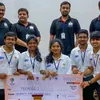The need to re-look at adolescent welfare programmes in India
Despite the Centre rolling out a large number of schemes, these programmes fell short in making significant improvements to the quality of adolescent lives across India.
As per data from India’s most recent Census, about 41 percent of India’s population is under the age of 20. If we meet the unique needs of the adolescent demographic (those between 10 to 19 years of age), we stand to reap the benefits of an entire generation at full potential.

Image : Shutterstock
However, despite the large number of schemes rolled out such as the Beti Bachao Beti Padhao, Kishori Shakti Yojana, Weekly Iron and Folic Acid Supplementation Programmd (WIFS), National Rural Livelihoods Mission (NRLM), etc, these programmes fell short to make significant improvements to the quality of adolescent lives across India.
We try and explore some potential causes here.
Carving a space for adolescents
The initial approach to adolescent-focused programming was targeted almost exclusively at girls, seeking only to make them suitable mothers through a focus on anaemia prevention and reproductive health, leaving young boys and men out of the discussion. This stemmed from a commonly held understanding of adolescents as an in-transition demographic rather than as a group of individuals in their own right.
Various civil society organisations have worked to demand that programmes and policies address the demographic as a whole that is both evolving and heterogeneous.
This is reiterated by Tanvi Jha, the International Centre for Research on Women’s (ICRW) State Coordinator in Jharkhand,
“In order to work with children and adolescents, a straight-jacket approach may not be able to bring about the desired change in their lives. It is thus important to have deep understanding on the circumstances of each adolescent in a community and undertake intervention in a case management mode thereby impacting on all the drivers that make them vulnerable.”
The whole is greater than the sum of its parts
These programmes also failed to account for the interconnected nature of the various aspects of adolescent life. When human beings do not lead their lives in silos, why would programmes that divide their lives into discrete components be effective at meeting their overall needs?
Consider for a moment the story of Saniya*, a 14-year-old who lives in Mumbai’s Shivaji Nagar, a slum built on the boundaries of the city’s largest landfill. Saniya is keen to stay in school after she finishes her elementary education – she dreams of being a doctor. But Saniya’s mother is worried that she would be vulnerable to harassment as she steps outside the neighbourhood, and if Saniya will have functional toilets for her to use in school, especially when she’s on her period or whether her teachers will show up.
Saniya’s father is adamant that she should stop going to school and stay at home and help her mother with household work. Besides, if he has to spend on her bus fare, he’d much rather spend it on his son who isn’t likely to get married and leave the house. So, it is more likely that Saniya will end up dropping out of school – like 32 percent of all adolescent girls in India will.
However, programmes that seek to encourage adolescents to stay in school rarely account for the various factors that influence whether girls like Saniya will stay in school. When programmes focus specifically on various siloed themes – such as health, education, livelihood, and so forth, without considering the interlinkages and spill-over effects that need to be accounted for, they are rarely able to achieve the impact they intend to.
The same goes with government policies, as the Municipal Commissioner for the city of Pune – Saurabh Rao, agrees:
“Government policies and programmes work in silos addressing the different needs of adolescents in isolation. There has to be some interlinking with what is delivered on the ground so that their needs are met as a whole and not in parts”.
Signs of change
In 2014, the Rashtriya Kishor Swasthya Karyakram (RKSK) was introduced to address adolescents as a demographic, and its model was built for both boys and girls. It included provisions to upgrade adolescents’ home-based skills, life-skills, and vocational skills, and provided information on existing public services. While the government worked at scale, there were a number of civil society organisations and institutions that complemented the state’s efforts.
However, much like in the previous instances, there was a significant failing in the implementation of these programmes. One challenge was the institutional tendency to work within silos rather than in collaboration with departments and external stakeholders, leading to loss of varied perspectives that would be required for a holistic view.
The RKSK, for instance, leveraged the network of Accredited Social Health Activists (ASHAs) in order to deliver on their community-level programmes. The ASHAs were trained through standard training modules that cascaded down from the national to the state-level, leaving them ill-equipped to handle challenges thrown up by local, cultural, and social dynamics.
By partnering with grassroot organisations to develop culturally sensitive-training modules, the government could have unlocked the full potential of the programme. As it stands, it remains a missed opportunity.
Collaborating for progress
There is an increasing acknowledgement that in order to effectively meet the needs of adolescents, it is imperative to bring together various stakeholders with a shared vision, pool resources to address issues, and build a collaborative platform to ensure accountability.
By synchronising various inputs, sharing data and best practices, relying on collaborative design and implementation, organisations can achieve maximum impact.
To this end, using models of collaboration like a community of practice are invaluable. A community of practice, simply put, refers to a group of people who share a concern or a passion for something they do in common, and learn how to do it better as they interact regularly. This model of action takes advantage of the fundamentally social nature of human learning.
With models like the 10to19 Community of Practice, currently operational in the state of Jharkhand, non-profits across the state are coming together to develop a holistic approach to adolescent welfare.
Such a model brings together researchers, experts, government leaders, grassroots workers, and other key stakeholders in one room – allowing for the real-time exchange of insights from the field, an iterative approach to problem solving, and the sharing of best-practices.
This also allows for the representation of a variety of interests – from sports for development and nutrition to livelihoods and skilling, and also allows organisations across multiple geographies and of different sizes to share and collaborate. In doing so, the community of practice also seeks to build and amplify a collective voice to drive collaborative action at the state-level.
The urgent need for such platforms is also echoed by Neera Nundy, the Co-Founder of Dasra, who argues: “The sheer magnitude of problems faced by adolescents every day in India highlight the fact that no one stakeholder is capable of transforming their lives and creating change at the scale and pace that is urgently required to move India forward.”
(Disclaimer: The views and opinions expressed in this article are those of the author and do not necessarily reflect the views of YourStory.)
(Edited by Megha Reddy)
* Name changed to protect privacy








